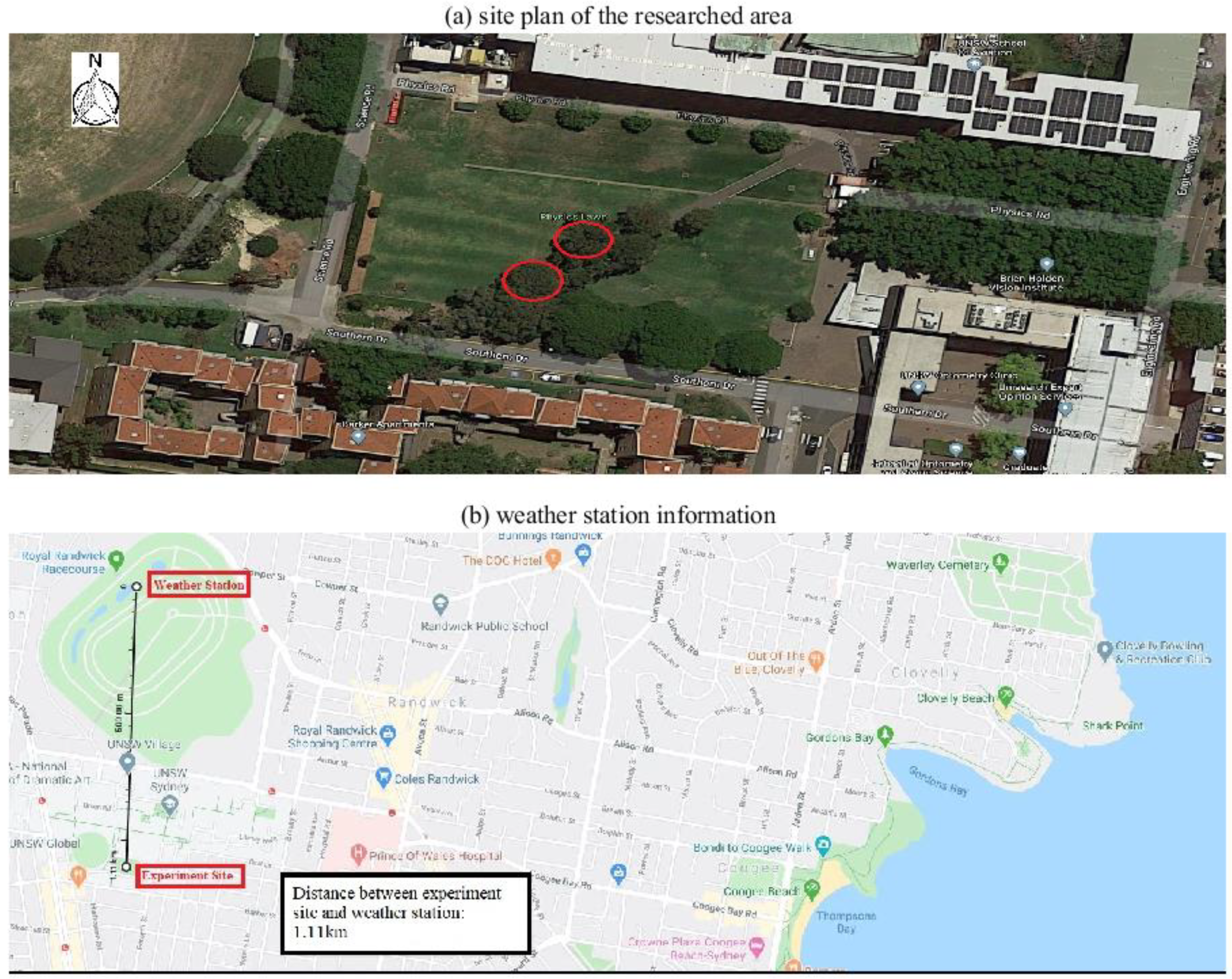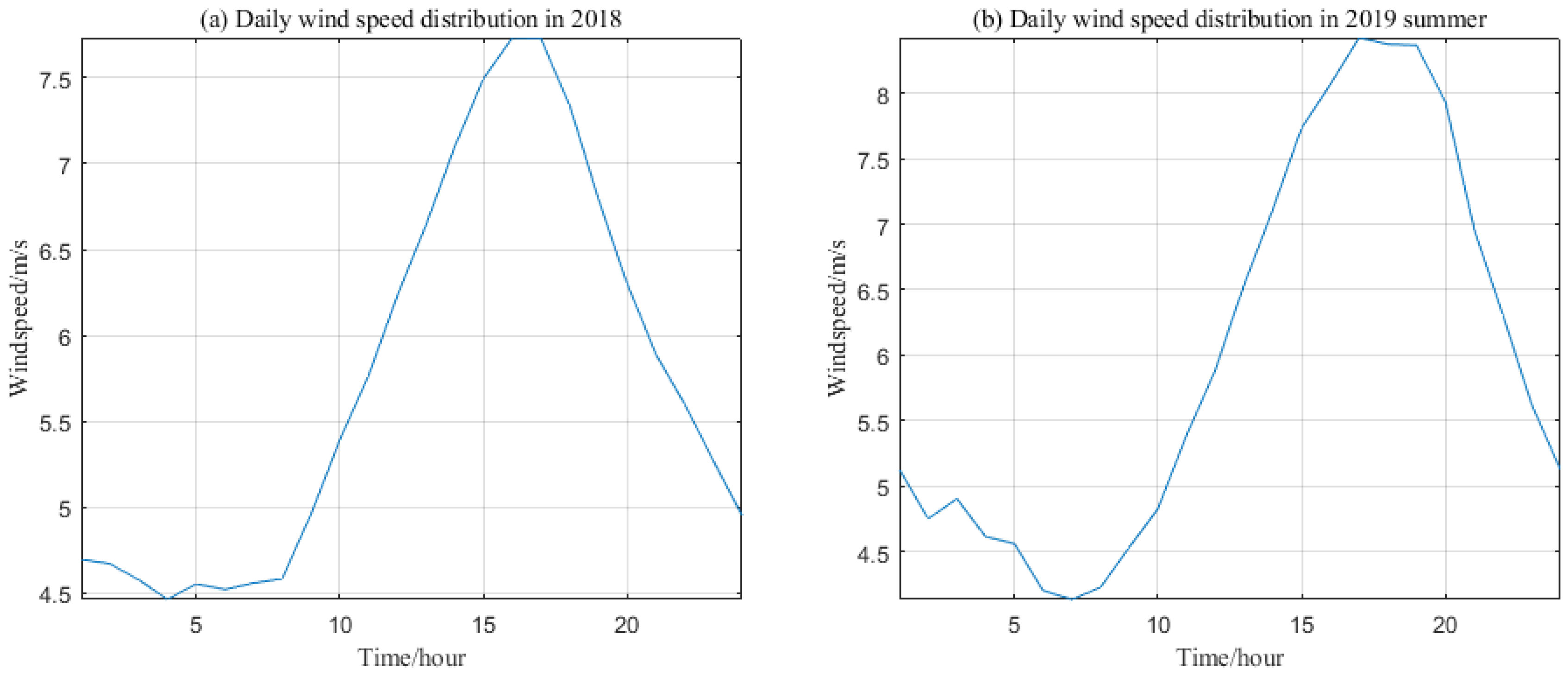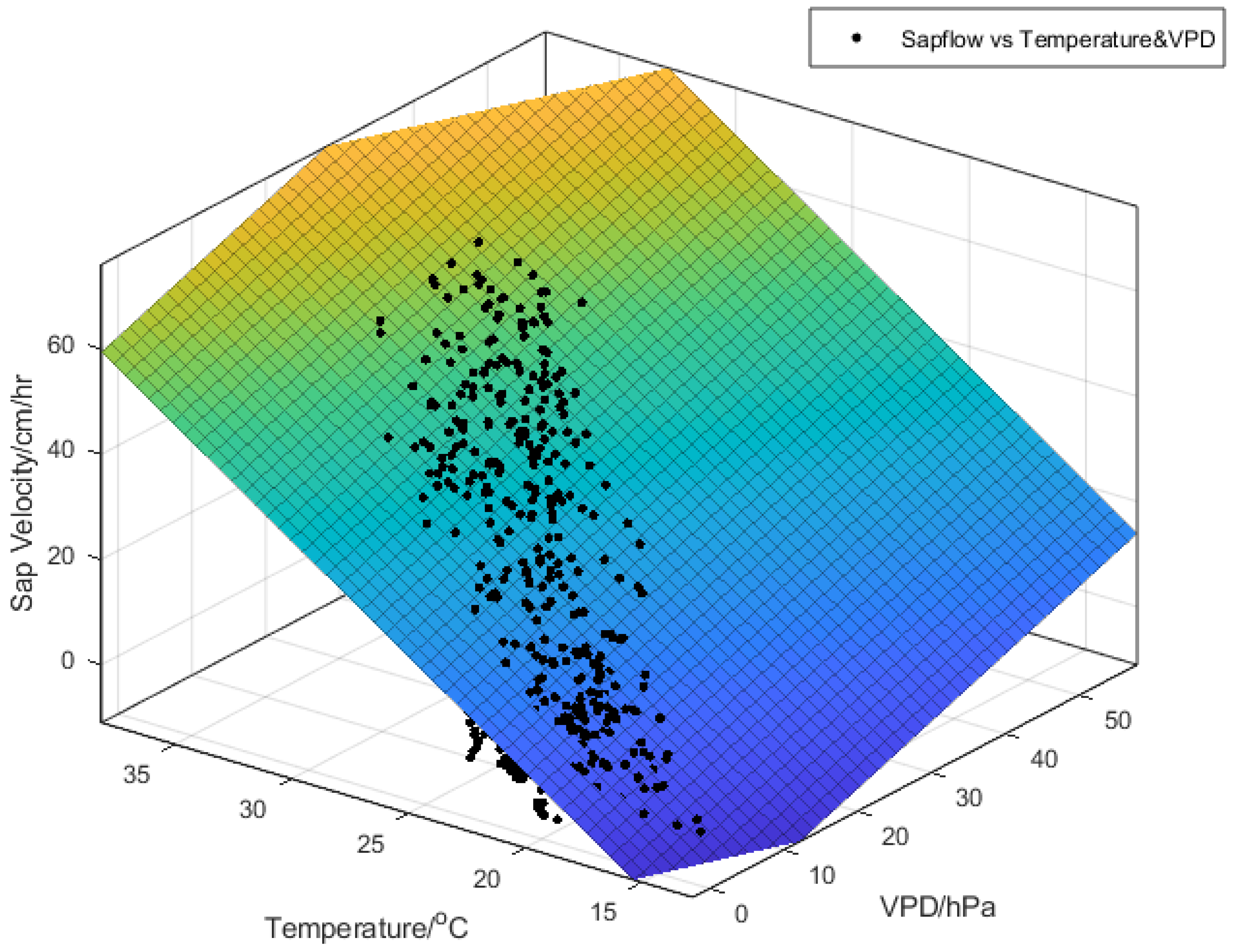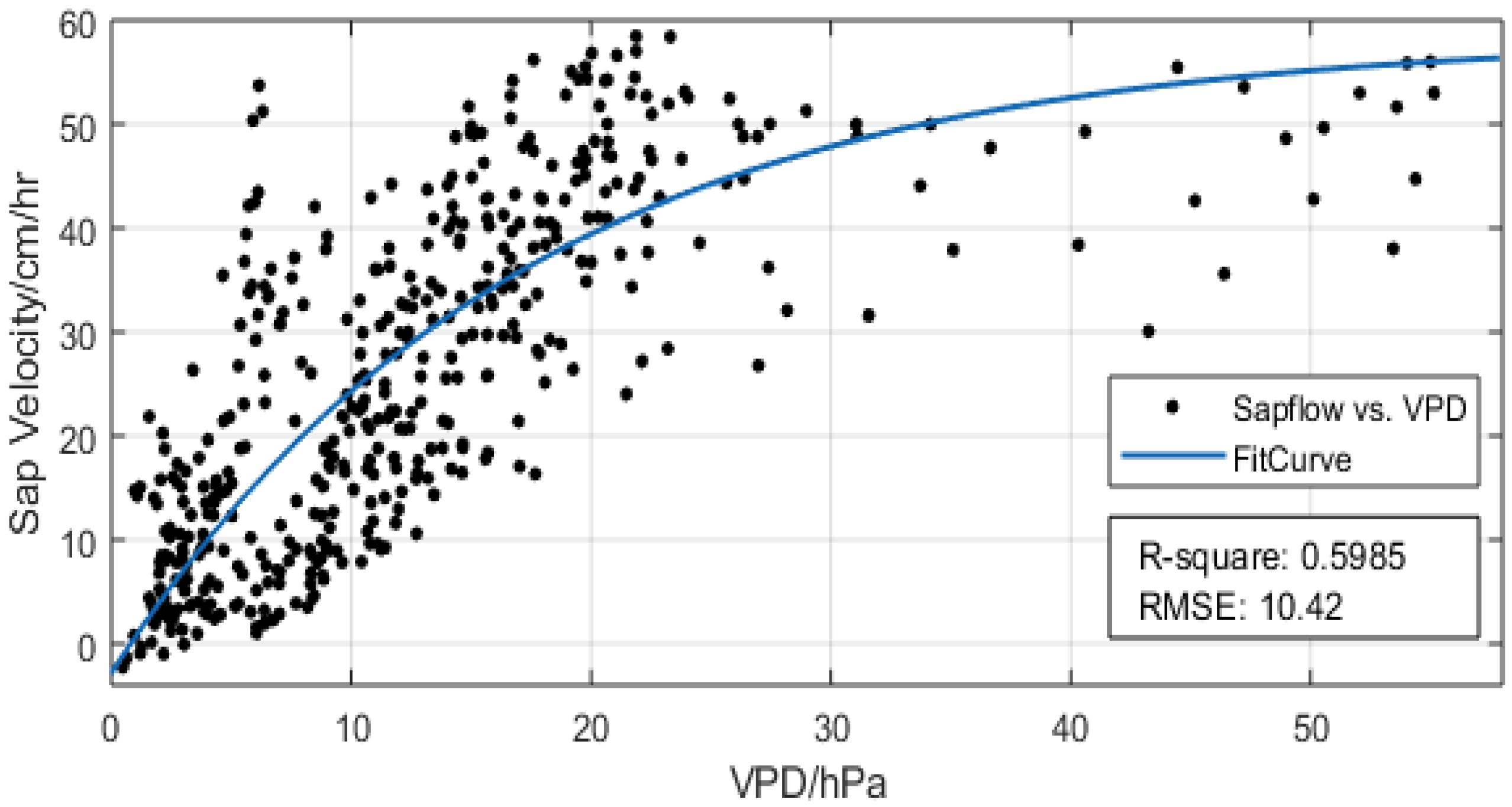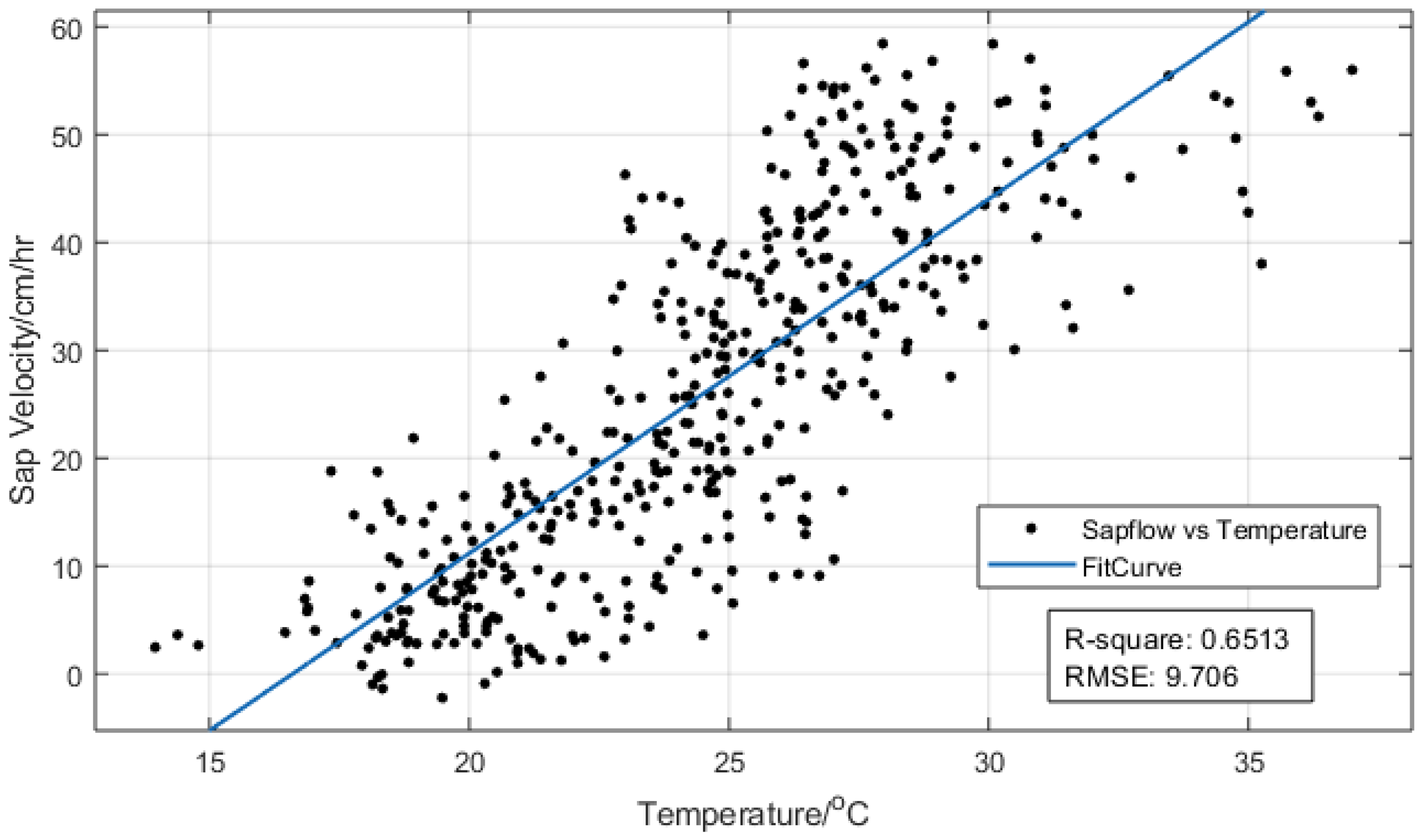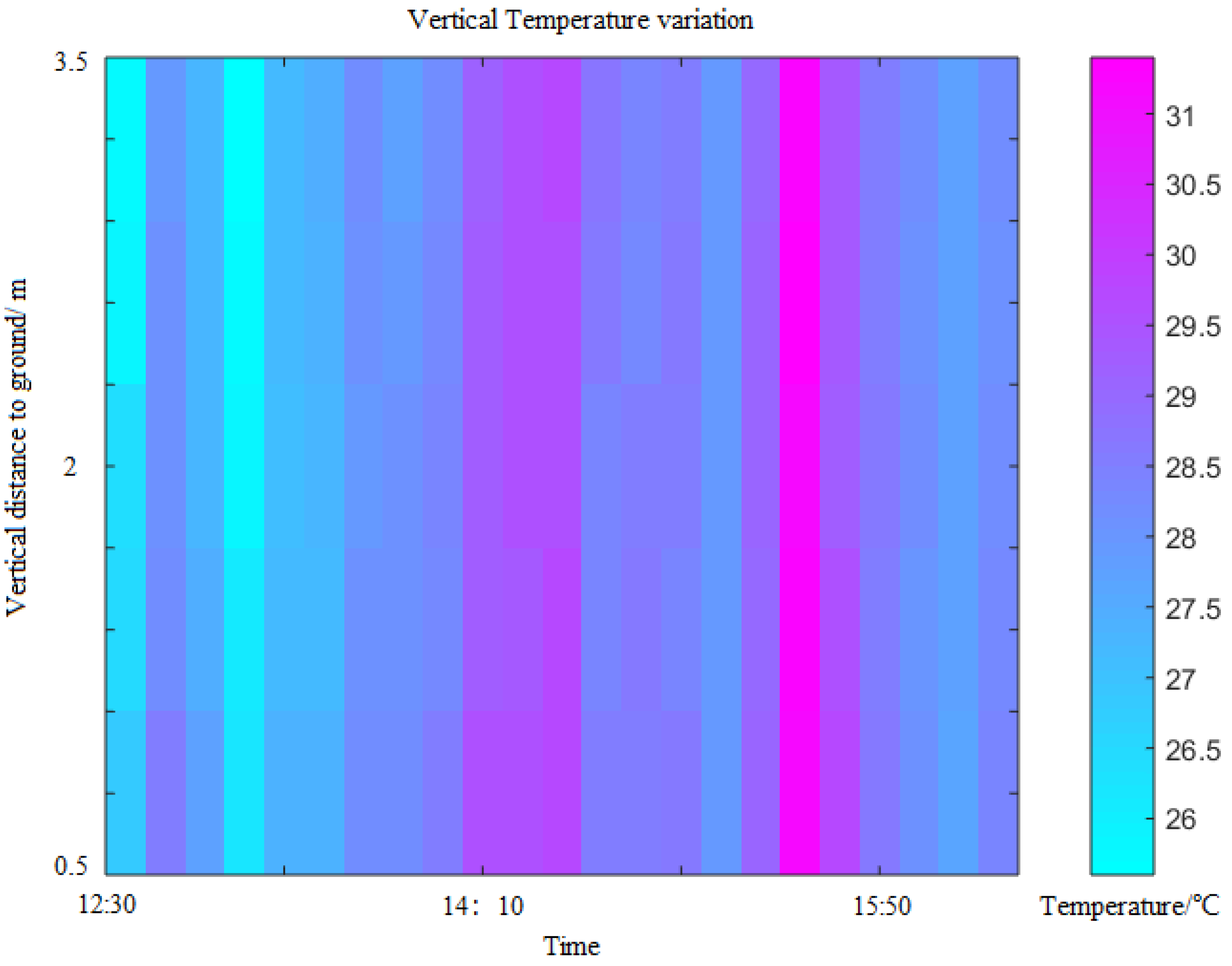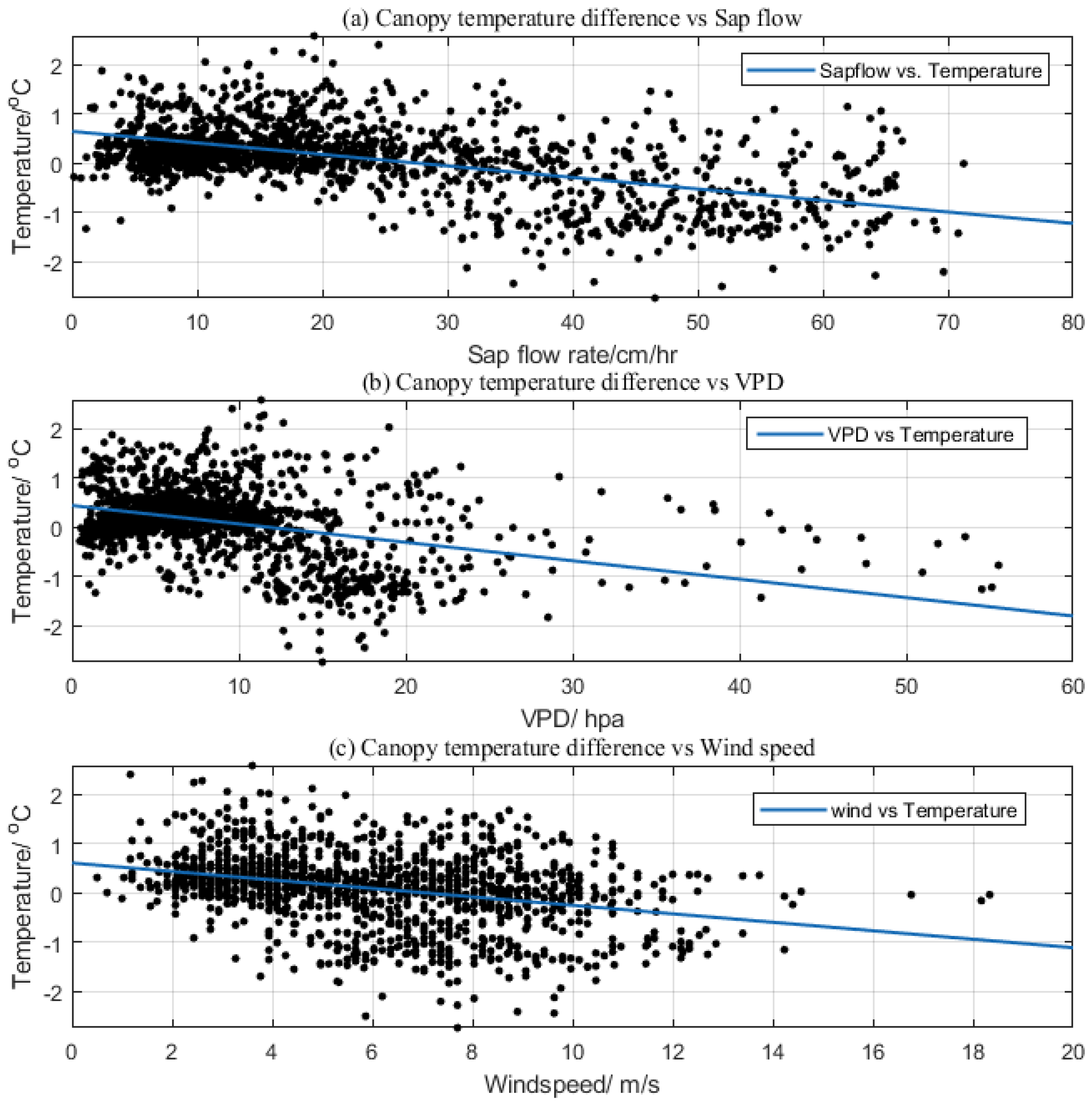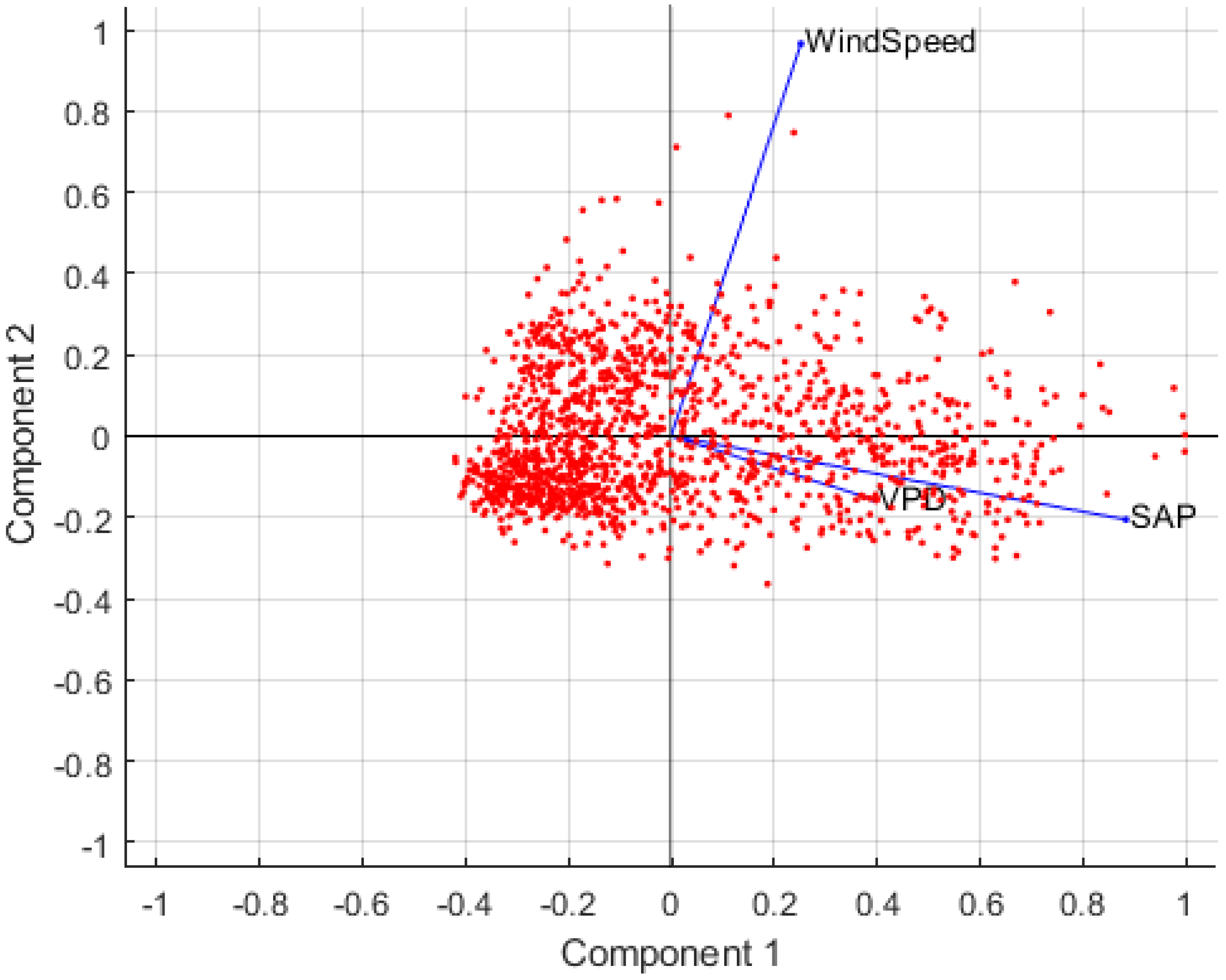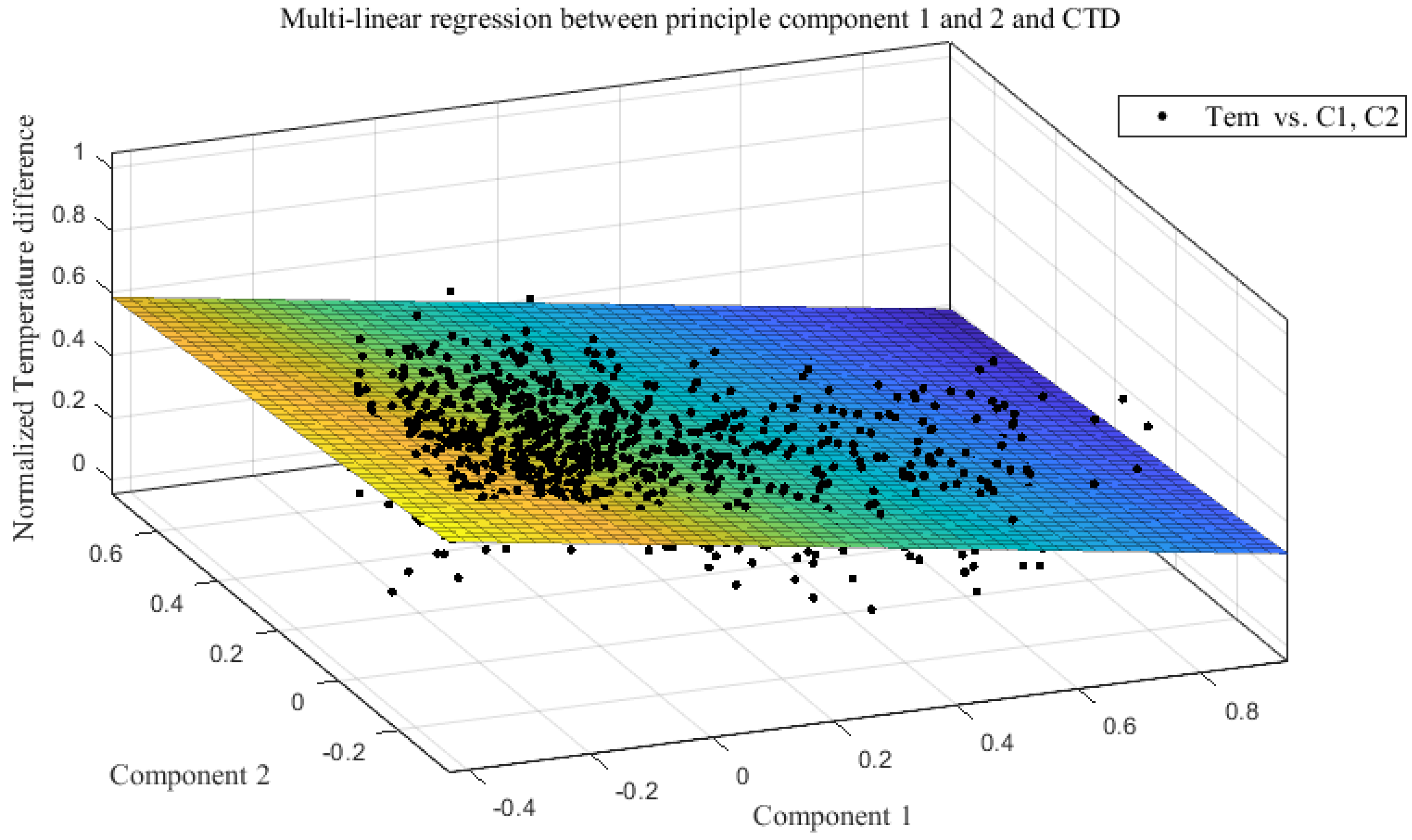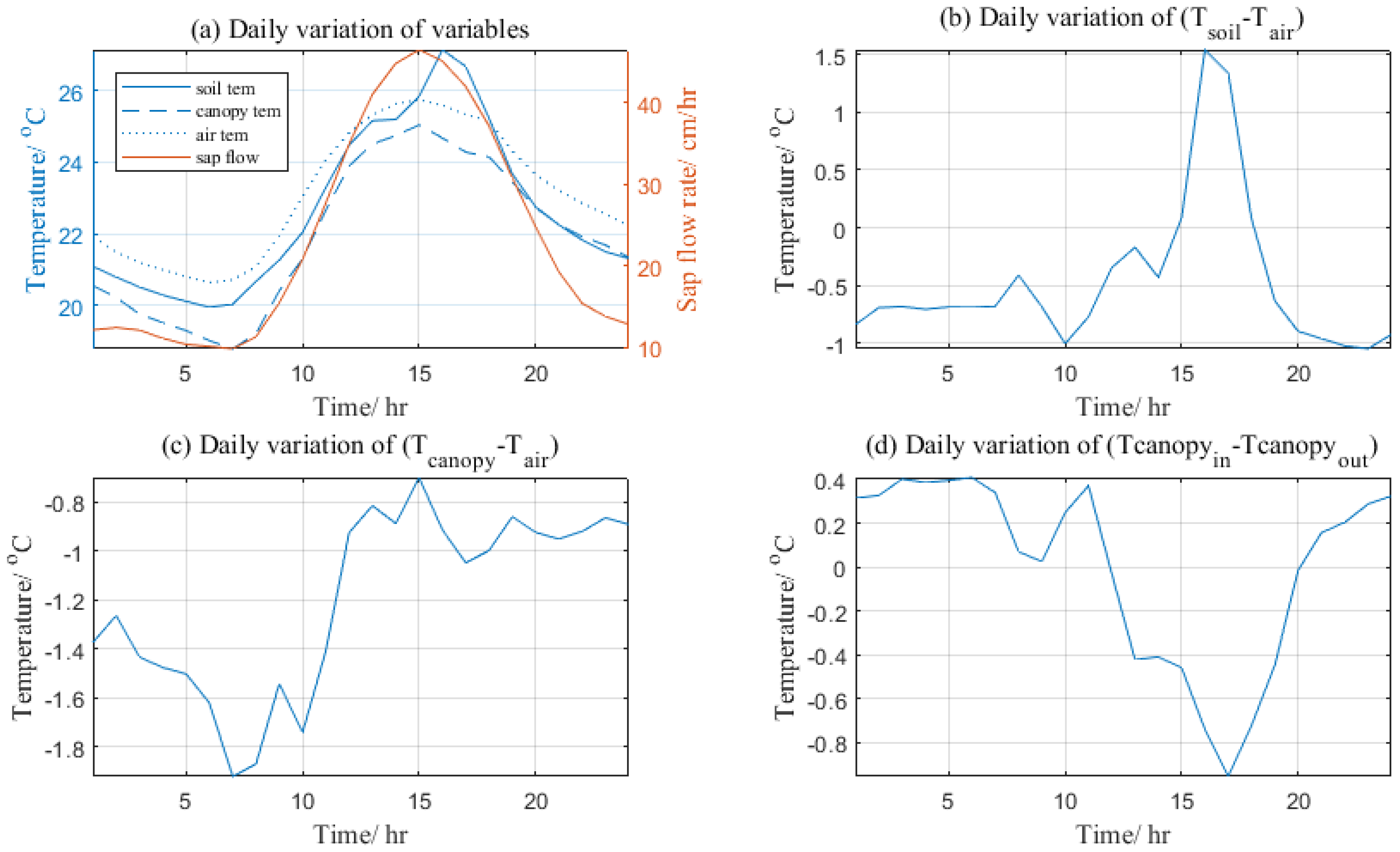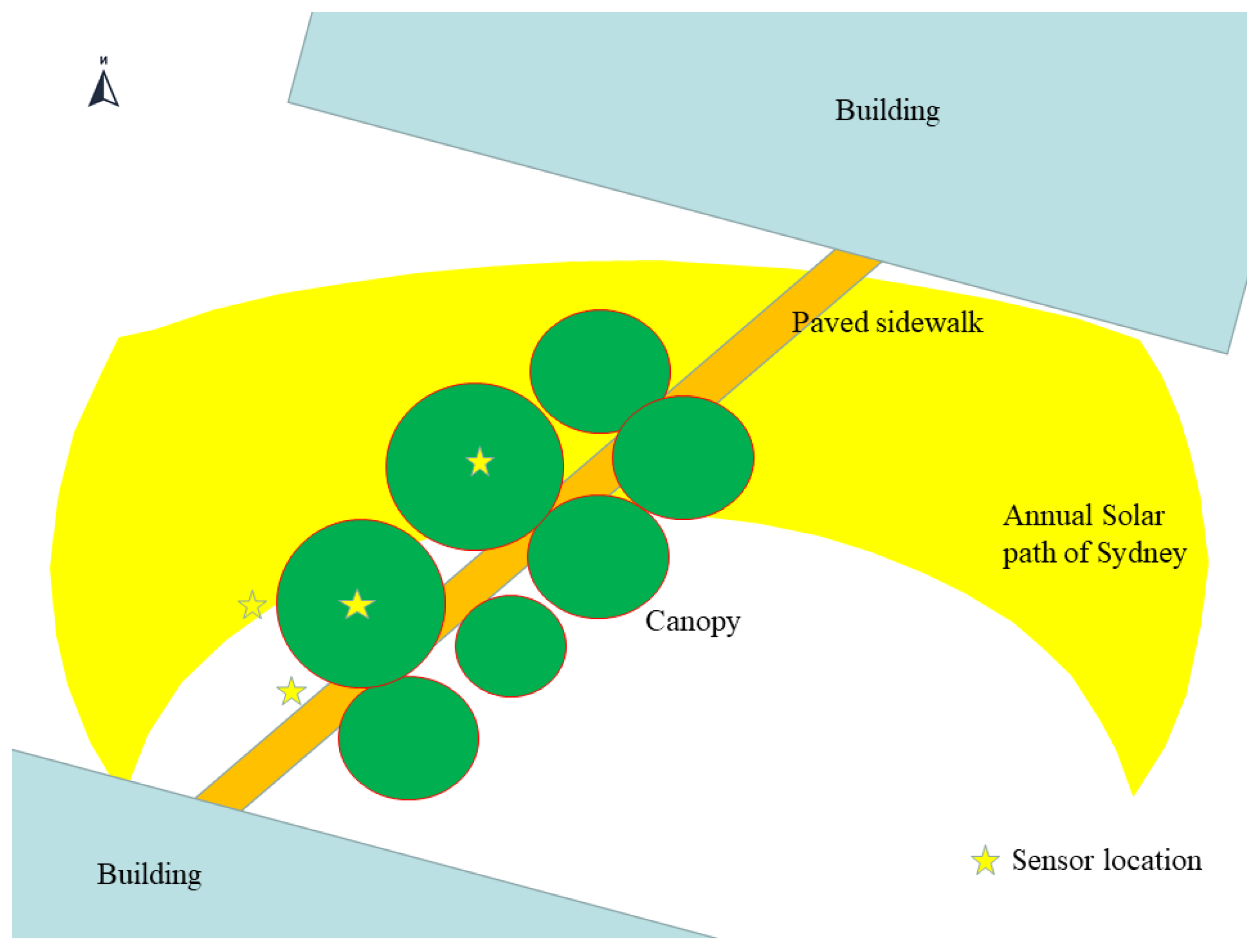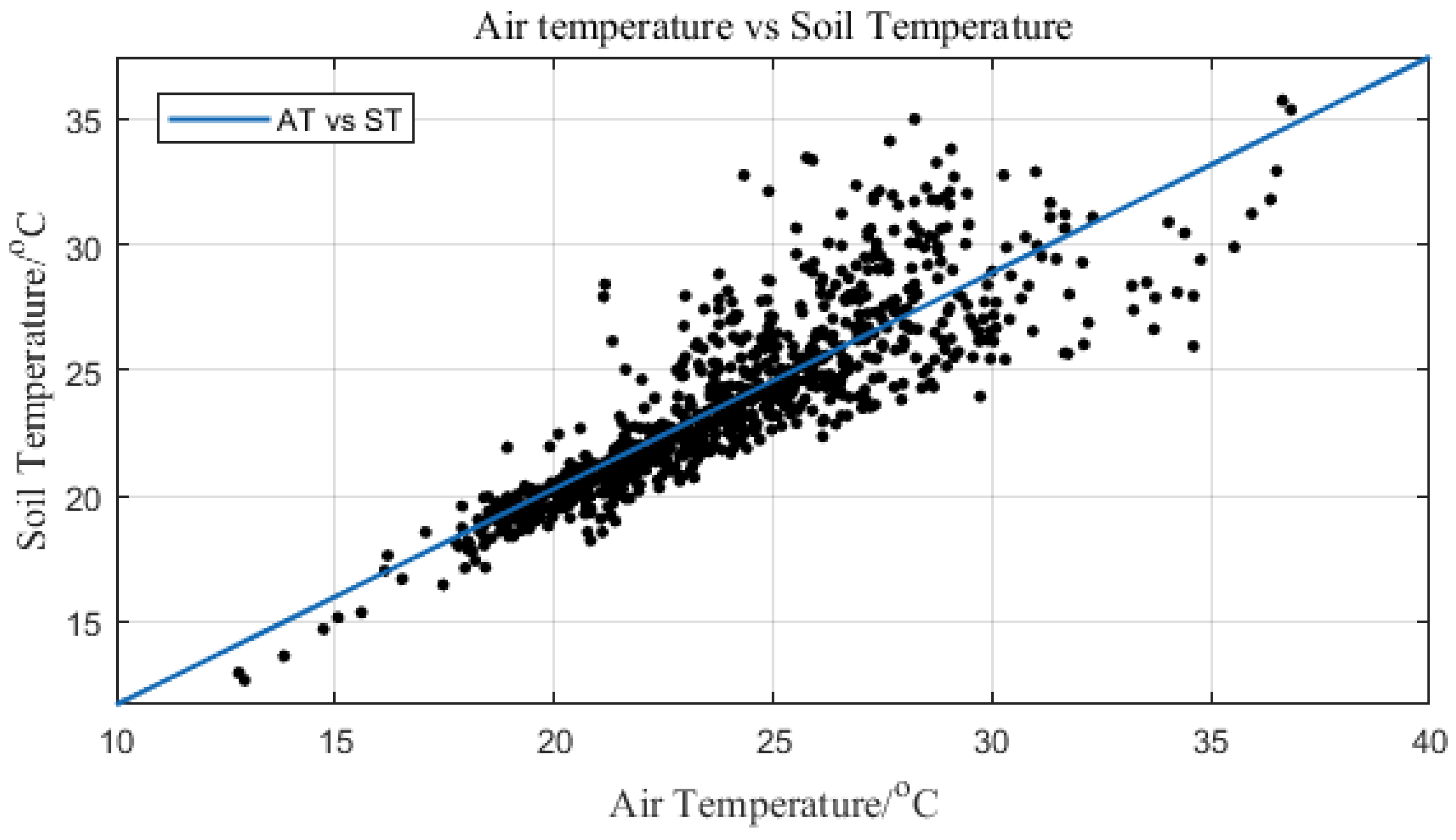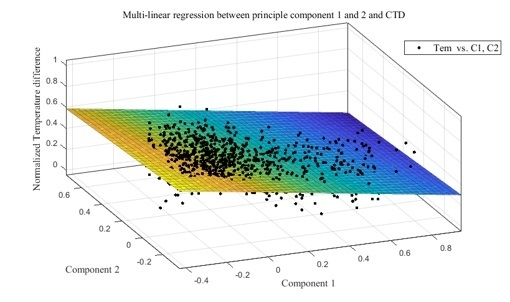1. Introduction
Climate change and the urban heat island effect have caused a worldwide issue of urban overheating [
1]. Urban overheating will increase the total energy consumption and peak electricity demands, thereby deteriorating outdoor and indoor thermal comfort, as well as the health of the public [
2,
3,
4]. In order to mitigate urban overheating, researchers have proposed a variety of options: integrating cool materials, such as reflective materials [
5] and radiative cooling surfaces, into facades and roofs [
6]; using cool pavement on roads [
4,
7]; and expanding green spaces in the urban environment [
8].
In the past few decades, the mitigation effect of trees has been proven effective by a large number of studies [
9,
10,
11]. The difference between the ambient temperature and the temperature in the canopy is usually used as an essential indicator of plant cooling capacity. For instance, the daily average difference of the air temperature between the shady area of a street tree and an open space is 0.9 °C in Melbourne, Australia [
12]; 1 °C in Munich, Germany [
13]; and up to 2.8 °C in Southeast Brazil [
14]. The cooling effect of trees mainly comes from shading and transpiration. The cooling effect caused by shading at a macroscopical level is very limited, as the albedo of the tree canopy is very similar to that of the ground surface, indicating that the total energy balance is not significantly affected by the presence of trees. Transpiration, on the other hand, alters the energy balance of the whole area by converting sensible heat flux to latent heat flux and has a cooling effect both locally and on a large scale. When sufficient water is supplied, the transpiration rate can be maximized, providing a considerable cooling effect. Plenty of studies have shown that the air temperature over vegetated land is significantly reduced after applying irrigation [
15,
16,
17].
Since research in forestry and agronomy usually focuses on large-scale crops and woodland, the heat flux over the land is easier to quantify to determine the transpiration cooling effect. However, in cities, where the surface is highly heterogeneous, the heat flux method is not suitable. Existing studies on urban tree cooling often use the sap flow method to measure the transpiration rate of a single tree or a small number of trees.
When switching to microscale studies, the transpiration cooling effect of urban trees can be explored more in depth. Researchers have found that the cooling effect of trees is closely related to their species [
18,
19,
20] and hydraulic architecture. The leaf area index (LAI) is considered to be a particularly critical parameter that determines the cooling capacity of trees. Trees with a high LAI can achieve more efficient shading and exhibit higher transpiration potential.
However, microscale studies also face difficulties. The temperature difference indicator reflects the cooling capacity of a plant to a certain extent, but this indicator can be environmentally sensitive. Remoting sensing research [
21] has found that in the core areas of several U.S. cities, the urban tree cooling effect was significantly affected by the surrounding thermal conditions. Compared with studies in forestry, experiments conducted in cities usually found larger temperature decreases under the canopy. For instance, an experiment in the Munich urban area [
22] reported that under the canopy, temperature reduced by 3.5 degrees, from 0.5 m above the ground to 4 m above the ground. However, in a
Picea abies L. forest, research [
23] found that the temperature only reduces by one degree every 4 m vertically under the canopy. Possibly, the warming effect of the paved street prevented the downward penetration of the tree cooling effect in the experiment conducted in Munich [
22]. This possibility emphasizes the influence of the energy balance of the local environment on the magnitude of the vertical temperature difference. Moreover, since a tree cooling mechanism differs from that of short vegetation, the vertical temperature cannot be used as the only indicator for transpirational cooling. Short vegetation directly provides cooling on the ground, while the transpiration cooling effect of trees needs to penetrate several meters to reach the ground from the canopy. The overall cooling performance is determined only after determining both the vertical temperature difference and the horizontal temperature difference between the inside and outside of the canopy.
At the same time, weather conditions could also affect the cooling effects of trees [
24]. The research in [
21] observed the variation of the urban tree cooling effect under different climatic conditions, and in [
25], more effective cooling was observed from trees in the dessert compared to trees on the coast. In scenarios where strong advection exists, the temperature difference under the canopy in the vertical direction and that between the inside and outside of the canopy may be affected. On the one hand, if the wind is dry and hot, the vapour pressure deficit (VPD) in the canopy will increase, and transpiration cooling will be stimulated [
26]. However, continuous dry and hot wind will also blow away the cold air that is mass-produced by the trees [
27]. On the other hand, if the wind is cold and humid, such as a sea breeze, transpiration can be weakened. At the same time, the canopy can directly block the wind, making it receive less cold from the wind compared to that received by the outside. If the space outside the canopy is also shaded, the temperature under the canopy can be even hotter than that outside. This possible phenomenon indicates that the effect of the wind may completely offset the cooling effect of transpiration. However, the effect of sea breeze on the cooling of trees has not been sufficiently studied, and many issues remain unclear. For example, in cities where the sea breeze is the dominant cooling mechanism, does planting more trees have an obvious cooling effect? How much tree cooling contributes to local temperature distribution? Answering such questions is crucial for mitigating overheating in coastal cities.
At the same time, some cities are affected by both desert and marine climates, such as Sydney, Australia. In Sydney, a synoptic condition exists where the east side of Sydney is adjacent to the Pacific Ocean and is affected by strong humid and cold sea breeze, while the west side of Sydney faces a vast desert and is influenced by the dry and hot desert winds. If a large number of trees are planted to alleviate urban overheating in the city, how should we arrange these trees spatially to achieve the most effective cooling? An analysis of the impact of sea breeze on tree cooling can help answer this question.
In this paper, when discussing the effect of the transpiration cooling of big trees, weather station data are used to include the impact of Sydney’s synoptic conditions, and the temperature difference between the inside and outside of the canopy was measured. The experimental site in this paper is about 2 km away from the coastline and is significantly affected by the sea breeze. As the elevation of the experimental site is higher than that of the eastern coast, the sea breeze can easily reach this area. Thus trees here are significantly affected by the sea breeze. After obtaining the transpiration rate, temperature difference, and wind speed, a principal component analysis (PCA) was used to determine the contribution of transpiration to the temperature difference inside and outside the canopy. At the same time, this research also studies the factors that affect the transpiration rates of plants. The results show that the sea breeze does play a crucial role in ooling, and sap flow also makes a considerable contribution to cooling. The analysis also shows that the daily peaks of sea breeze and sap flow do not overlap, indicating that the introduction of trees in coastal cities can complement the cooling of the sea breeze. This result answers the above questions and affirms the plant’s cooling potential under sea breeze conditions.
In the study, attention was also paid to the vertical temperature gradient below the tree, and the influence of the ground surface on the vertical temperature distribution was discussed according to the measurement results. This result further emphasizes the effect of the ground surface on the cooling capacity of trees and highlights that when measuring the cooling effect of trees in a microenvironment, the vertical temperature difference cannot be used as the only criterion to assess the cooling capacity of plants; the assessments should instead be made after correcting the possible impact of the surface. We believe that this study makes an important contribution to rationalizing the layout of urban greenery to achieve a better mitigation effect.
4. Discussion
4.1. Horizontal Cooling Effect
In this experiment, the temperature difference between the outside and inside canopy was measured. The analysis indicates that the synoptic conditions in Sydney may have made a significant contribution to the results.
Changes in the transpiration rates of large trees depend largely on direct radiation changes, while regional synoptic conditions rule the wind in the studied area. The study area is close to the coastline and faces open spaces in both the eastern and the western directions, making the sea breeze the dominant factor in the surface energy balance despite the impact of downward shortwave radiation input. Further, the cooling effect of transpiration is negligible compared to the cold brought by the sea breeze. Studies conducted in Munich [
13] reported that the sap flow has a significant relationship with the difference between the temperature under the canopy and that outside the canopy. Munich has a mild climate, and in the researched area, no climatic conditions (such as a stiff sea breeze) were observed. This indicates that the presence of a windy environment must be considered before using plants for transpiration cooling. The difference between the results of this study and the results in [
13] indicates the high dependence of tree transpiration cooling on the environment, especially on local wind environments and under regional synoptic conditions.
In order to make a comparison between variables, the daily variation of several variables was calculated, as shown in
Figure 11 (daily variation is calculated as the average at a specific hour equal to the sum of all the data measured that hour during the two weeks divided by the total number of data at that specific hour). The maximum daily temperature difference appears after around 17:00 (
Figure 11d), which is earlier than the peak of the wind speed (
Figure 3b) but later than the peak of the sap flow rate (
Figure 11a). This indicates that the wind may exert influence on the temperature difference in the afternoon and delay the time of the peak temperature difference. At the same time, starting from 11 am, the difference between the canopy temperature and the air temperature remained at a similar level (
Figure 11c). In our experiment, this also indicates that the wind is likely to dominate the energy balance and negate the effects of other factors in the local space under the canopy. If the wind is not the dominant factor, the variation in sap flow and solar radiation will lead to a significant peak on the curve in 11c after 11 am.
It should be noted that the temperature sensor outside the canopy was located in the downwind direction for most of the time in the afternoon, as shown in
Figure 12. The northeast wind was significantly blocked by the large thick canopies and the layout, causing the wind in the downwind direction in the local environment to significantly weaken. This could be the reason for the results of our experiment: The wind cooled the canopy more than it cooled the outer areas in the downwind direction. Furthermore, if a sensor was placed in the upwind direction outside the canopy, the results indicate that the sensor was able to record a lower air temperature.
The PCA helped us eliminate the correlation between variables, showing that transpiration made similar contributions to cooling compared to the wind in the experiment. As mentioned above, the peaks of the daily sap flow, temperature difference, and wind appeared in sequence during the afternoon. This pattern suggests that in the early afternoon, when the daily maximum air temperature is most likely to occur, transpiration cooling plays a leading cooling role in the cooling mechanism. The transpiration cooling and cooling of the sea breeze complement each other in different periods under specific synoptic conditions, providing the city with a considerable cooling effect in the daytime and further emphasizing the critical impact of trees on the local climate.
However, it should be noted that after the principal value analysis, the correlation between the temperature difference and the principal component remained limited because the transpiration cooling of trees only accounts for a part of the cooling effect, and the shading effect is also an essential cooling mechanism of trees. Though the shading effect was not able to be analysed in the experiment, the effect of shading should not be ignored. In the daytime, changes in the incoming radiation intensity and direction can affect the temperature difference between the outside and inside of the canopy.
Moreover, a sharp peak in the soil temperature is shown in
Figure 11a. This is because the soil was receiving direct solar radiation at this moment. During the time when the the soil temperature peak occured, the recorded soil surface was not shaded by the canopy. Hence, a sharp rise in the soil surface temperature was observed. This result also underscores the importance of shading effects in tree cooling mechanisms.
4.2. Vertical Cooling Effect
In the studied area, a vertical temperature of 0.5 °C from 0.5 m to 3.5 m was observed under the canopy. This value is relatively small compared to the values in urban tree cooling studies, as mentioned above [
22]. The surrounding surface conditions made the largest contributions to this result.
Different ground surfaces have different thermal properties, optical properties, and evapotranspiration capabilities. Therefore, under the same environmental conditions, different ground surfaces will have different surface temperatures and lead to a diverse vertical temperature and humidity distribution near the ground. Studies that distinguish vertical temperature differences are usually conducted on built surfaces like paved streets [
22]. The warming effect of built surfaces enlarges the vertical temperature difference. This warming effect is considerable, especially when the trees are sparsely distributed. However, in our experiment, the trees are located on a dense grassland, where the soil surface remains moist most of the time. The transpiration of grass and direct evaporation from the soil cause a considerable cooling effect, and the cooling effect of the lawn and canopy work together, resulting in a more uniform vertical temperature distribution.
To confirm the cooling effect of the lawn on our measurements, a regression of the surface soil temperature and air temperature was developed, and the results are presented in
Figure 13. According to the fitting equation, the projected soil temperature is significantly lower than the air temperature. When the air temperature is 30 °C, the projected soil surface temperature is 28.9 °C at the experimental site, and the temperature difference is 1.1 °C. When the air temperature is 35 °C, the projected soil surface temperature is 33.1 °C, and the temperature difference reaches 1.9 °C. This means that the cooling effect of the lawn did contribute to the vertical temperature distribution.
4.3. Limitation of the Research
Due to the complexity of the urban environment and the experimental conditions, the following limitations exist in this study. In this experiment, the sap flow rate was recorded but not calibrated. Hence, only the sap flow pattern was analyzed. The transpiration cooling ability is thus unable to be quantified since the transpiration cooling power cannot be calculated. Part of the data used in this experiment was taken from the nearest observation station. The distance between the experimental site and the nearest station was around 1.1 km, and the conditions of the station were similar to those of the experiment site. Since distance remained between the observation stations and the experimental site, the correlation coefficient between the station observation and site data inevitably decreased, although some studies have shown that it is feasible to use data from nearby observation stations in this kind of research. Considering the analysis results above, the influence of wind may cause a significant difference in the air temperature from the east and west sides of the canopies. However, this difference was not quantified in the present measurements since only one side of the canopy was measured. Also, the absence of radiation data can also have an impact on the multi-linear fiting results of the principle components. The R square value of the current result may be lower than the fitting result using principle components that consider radiation.
Due to the complexity of the urban environment, the results of this experiment may not be suitable for all places that have a strong coastal breeze because the local wind environment is also greatly affected by the terrain and building layout. If there are large buildings present in the upwind direction, the contribution of the wind field to the cooling of the local environment could be significantly weakened, so the role of the transpiration cooling of the plants in such scenarios is more critical. However, the shading effect produced by the possible appearance of buildings may also obfuscate the shading effect of plants. These scenarios also need to be investigated. The results of this experiment are only suitable for occasions where the local wind environment is profoundly affected by weather conditions.
5. Conclusions
The results of this study emphasize the importance of climatic conditions for the transpiration cooling effects of trees in urban overheating. We found that transpiration clearly contributes to decreasing the temperature, even under strong coastal wind conditions. Therefore, in cities, where the climate is dominated by the sea breeze, the side of the city that is far from the coastal line is less affected by the sea breeze, but transpiration still plays a critical role in the cooling of these areas. At the same time, the experiment also showed that the patterns of sea breeze and sap often do not coincide and that trees and the wind can complement each other in terms of urban overheating mitigation at different times of day. Hence, even in the areas near the coast, transpiration cooling could still be useful.
Furthermore, for cities in the desert, the situation may be opposite to the situation in this article. Dry and hot desert wind can bring heat to the city. However, the desert wind will also increase the VPD of the local space, thus amplifying the transpiration rate. Therefore, in such cities, the mitigation potential of trees planted in well-ventilated areas can be maximized. The canopy barrier can reduce the invasion of the desert wind into the city and further enhance the value of the trees in alleviating urban overheating. At the same time, it should be noted that sufficient irrigation of trees in these areas may be a precondition for effective mitigation.
At the same time, the measurement results and analysis of the vertical temperature distribution emphasize the influence of the microenvironment on the cooling effect of the trees. In a highly built urban environment, the warming effect of surfaces, such as concrete sidewalks or asphalt roads, is considerable at noon in the summer, and the warm air flow near the ground surface can be substantial. If the canopies of the trees are not large and dense enough, the warming effects of the surroundings can easily conceal the shading and transpiration cooling effects of the trees, leading to a decreased cooling effect. Therefore, in urban landscape design, to achieve effective vegetation cooling in a highly built environment, trees with a high LAI and a large canopy projection area must be selected.
